The first Rhinosceros Beetles or Copris hispanus I encountered a good few years ago now, were happily working away in a big pile of cow dung deposited on a path we were walking in the Sierra de las Nieves mountains, near Ronda. My friends were not as fascinated by them as I was and hurried me along, thus depriving me of more photographs!

One summer night a beetle flew in through a bathroom window and spent the night in a bath, unable to climb out
I had more sightings of the big, black horned beetles whilst out and about in the region and around, and in, my home and garden in Sotogrande. There were no large animals in the immediate vicinity, so no immediately-local dung – unless they can improvise with dog pooh, of which there is probably plenty. The nearest large animals in that locality are horses, of which there are many; Sotogrande is an internationally-known centre for Polo, so plenty of lovely ponies, then there are various stables and riding centres, but all perhaps 1-2 kilometres away. There are old oak stands remaining though, so I assume the conditions required for breeding are in still place and of course the reason we see them around villas are the lights that attract them at night.
Copris hispanus– The Rhinoceros Dung Beetle
These large black bulky beetles have large wings folded under the elytra (wing covers) and can fly strongly. They stay hidden during the day, but are on the wing at dusk in the spring and summer and are attracted to lights; they are generally noticed when they come to house lights.
Scientific name: Copris hispanus (Linnaeus 1758) Family: Scarabaeidae; Body length : 25-40mm Distribution: Found throughout almost all of Europe, North Africa, Asia Minor & the Middle East. In Spain the stronghold of these fascinating beetles is in the south of the country where cows and sometimes horses, wander freely in the woodlands and where there are still a good number of small farms with livestock reared in more traditional ways. They are less abundant in the north of the country where farming methods are more intensive.
There is marked dimorphism of the sexes of this species. The male has a recurved ‘horn’ on his head and on the scutum, a hollow topped by a high comb whilst the female has only a triangular plate.
Habitat: These large and impressive beetles were originally inhabitants of old oak stands, but they are gradually finding their way into the neighbourhood of man’s habitations and the larvae may now be discovered in compost heaps and the like.
In the natural habitat of the forest, larval development takes place in old tree stumps and takes from two to three years. Fully grown larvae measure up to 120mm and pupate in a large oval chamber.







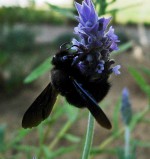
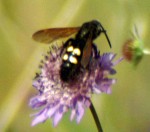
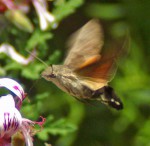

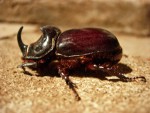
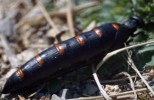
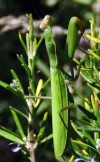

This morning awoke to find a rhinoceros dung beetle on the patio without your information I would have been lost great site
thank you
Adrian
LikeLike
Thank you for your comment and for finding the blog. The rhino beetles are great aren’t they? We used to find them in the bath sometimes if we left a window open at night. Easier to pick up than spiders!
LikeLike
A female fell in the pool tonight. (Moraira) Scared me shitless 🙂 felt compelled to help her out though. Had never seen one before and now i know what it was thanks to you.
LikeLike
Thanks for sharing the moment Michael! I’m happy to hear you helped the poor thing out of your pool; there’s many a beetle that meets its demise that way.
LikeLike
Hi Theresa,
My dogs were curious about something, then went racing off down the garden, Then I heard a noise from a honeysuckle bush near to where I sat, so I went to look. Eventually got quite a fright as something clattered near my feet. Before my dogs came back and caused trouble I scooped it up into a small (empty) candyfloss bucket. Much studying and image search took place – I thought the horn resembled a rhino’s, having seen many when I lived in Africa, but simply googled ‘horned beetle spain’ and came across your site.
Fantastic. I studied him for a while, taking loads of photos before letting him out onto my desk when he walked to the edge and fell off. Again afraid he might get hurt I scooped him up again, finally releasing him into what I hope is a safe area of my Alhaurin el Grande garden.
Thanks for the information contained here, it was immensely interesting.
Ann
PS Do we know if the horn has a purpose, or is it purely ‘ornamental’?
LikeLike
Thank you for your story Ann, the beetles are great aren’t they? The beetles’impressive horns are indeed used for fighting and size and strength matters to their breeding success! If you have a healthy population of them you probably have the equally fascinating and large Mammoth Wasps too? (Black with yellow markings) The wasps parasitise the poor old beetles’ larvae. More about horns here – https://www.sciencenews.org/blog/wild-things/rhinoceros-beetles-horn-shape-reflects-fighting-style
LikeLike
4th July 2015 – just found a poorly looking specimen in our street, minus one front leg. It now rests in our communal garden but I don’t think it will live long. We live in La Cala de Mijas, Costa del Sol and there are a few cork oaks still growing nearby, and of course, there are plenty of horses around!
Areta
LikeLike
Aah, shame, poor old beetle- at least you rescued him and have given him a pleasant place to end his days! The beetles burrow into the ground when not rummaging in dung or otherwise roaming around, so you may never know whether or not he survived, but at least you’ll recognise him if he does resurface! Best wishes
LikeLike
Large round black insect with a loud buzz. See them quite often here. I’m in south eastern Spain close to the coast. What can it be?
LikeLiked by 1 person
I’m intrigued! It could be a number of things, but need a few more details! How big is big? Is it buzzing whilst flying? Is it visiting flowers? Do you think it’s some kind of beetle or might it be a big Violet Carpenter Bee?
LikeLike
Hi, we live in Mallorca , it has just rained here after a long hot summer, and we are now inundated very night with these beetles. last night I counted 130 of them under our porch!
They are attracted to the light , in the town every street lamp has clusters of them. Pretty impressive to see!
LikeLike
Wow, must be quite a sight! They do seem to be attracted to lights, but I’ve no idea what might have brought in that number. Perhaps there’s been a recent mass emergence, they are a type of dung beetle so would have originated from somewhere there’s a good supply. Can you tell if they are males or females?
LikeLike
Our rented holiday house in Aracena in the middle of chestnut groves had no less than 20 of these beetles arriving on the patio when we had the light on. It was raining hard but they were buzzing around happily like mini helicopters. Fascinating. Mostly females. I wonder if they have any natural predators as there was a huge and beautiful salamander also on the patio…?
LikeLike
Wow- that must have been quite a sight. I’m glad you found them fascinating – many people would have been freaked out by so many flying around them, especially as they’re quite clumsy! I couldn’t say for sure, but salamanders, like most lizards, are known to have an eclectic diet, eating a variety of invertebrates, worms and even smaller salamanders, so if yours was a big one then it may have snacked on a rhino beetle or two.
LikeLike